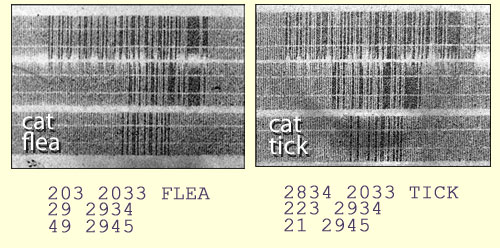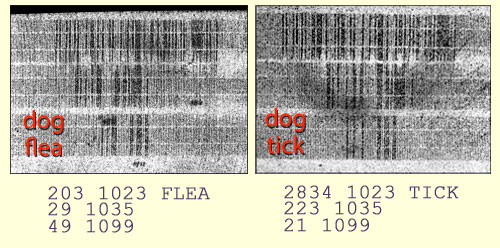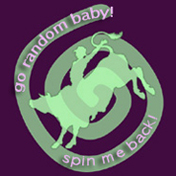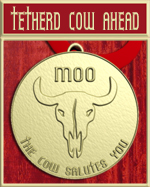Wed 19 May 2010
Shoo!TAG Unplugged
Posted by anaglyph under Gadgets, Hokum, Numbers, Science, Skeptical Thinking, Technology, WooWoo
[15] Comments
Recently on Tetherd Cow Ahead we did a simple science experiment that allowed us to reveal a visual representation of the magnetic data on the stripe of a standard swipe card. You will remember that one of the magnetic cards I examined in that post was the dubious Shoo!TAG, which according to its inventors, is a miraculous device that repels fleas and ticks (and other ‘targeted’ pests!) from you or your pets by using ‘the power of the bio-energetic field which surrounds all living thing to create a frequency barrier’.
It turns out that some pretty smart people read the Science Experiment post, including commenters MomentumV and the inimitable Dewi Morgan. To my great surprise, both MomentumV and Dewi were actually able to look at my images and read the card’s encoded data directly off them – something I had never anticipated as possible – and make some great initial headway in decoding the mysterious power of the Shoo!TAG.
The results were cryptic at first. Surprisingly, all of us missed the significance of the letters A E L F, which appeared on the card, along with a string of numbers. I threw up an image of the second ‘Cat’ tag I had (this one supposed to ward off ticks) and Dewi came up with a clever little javascript to auto-decode ShooTags. A number of things then dropped swiftly into focus. We were looking at the data backwards. You can experience the discovery as it happened in the Comments on that post – it makes for a wonderful scientific ‘Aha!’ moment.
This is what Dewi found when he ran the data through his script (all the technical details of how it was achieved are explained in detail on Dewi’s journal): ((It’s probably the best description of how mag stripes work anywhere on the net – trust me, before Dewi came along, I looked!))

I’ve arranged the characters to correspond with their equivalent position on the cards. Note that the words ‘FLEA’ and ‘TICK’ are actually encoded as letters in the magnetic data.
In the interests of science I decided to expand our dataset, and to this end I acquired a pair of the ‘Dog’ ShooTags from a nearby pet supply shop. ((‘Do you know how they work?’, the sales assistant asked. ‘No-one knows how they work. It’s bunk’, said I. She seemed nonplussed.)) Dewi was kind enough to decode them also:

There is some numerical symmetry and repetition apparent here, and the obvious conclusion is that the various numbers simply signify ‘Dog’ or ‘Cat’ and ‘Flea’ or ‘Tick’. ((There are a number of ways the digits can be paired with the actual words in the code or with the animal on which the tag is supposed to be worn.)) Melissa Rogers, one of the CEOs of ShooTag claims, however, that the tags are ‘encoded with earth friendly frequencies’ in the form of a ‘three dimensional or tri-vector signature imprinted onto the magnetic field of the card’ and the ShooTag FAQ says that ‘we are only using the energy field that is already emitted from an animal and adding a few frequencies that we know that specific insects do not like’. The implication is, therefore, that the data on the cards is some kind of numerical representation of these supposedly effective frequencies. I think you will agree with me that it beggars belief to think that anyone would base a serious 21st century product on this concept. It makes wearing a ShooTag the modern equivalent of the old superstitious practice of warding off evil spirits by carrying around a piece of paper with numbers written on it.
Whatever the characters signify, there is no known scientific mechanism that would explain how a few lines of magnetic data in a common encoding format, written to a card that is designed to be swiped through a checkout terminal, could have any effect at all on fleas, ticks, mosquitoes or any other insect.
[NOTE: I think there is still probably some kind of screwy logic to the numbers on the cards – if there’s anyone out there with some expertise in cryptography, or who feels like going on a treasure hunt, any extra information is welcomed. Places to start: Rife Frequencies, Quantum BioEnergetics and Quantum Energy Wellness (where you will see the term ‘tri-vector’ bandied about some more). Who knows whether any of these are relevant in the case of ShooTags, but it would be hugely satisfying to find out…]
15 Responses to “ Shoo!TAG Unplugged ”
Trackbacks & Pingbacks:
-
[…] 2005 Tetherd Cow RSSBluetooth?Shoo!TAG UnpluggedThose Wise Guys AgaineBaitInnovation is Sincerest Form of FlattryJust DessertsOozeEven More […]
-
[…] Asiasta tarkemmin kiinostuneille voi suositellla Tethered Cow-blogin ansiokasta selvitystä. […]
-
[…] done that work for me.  Major props go to Anaglyph for masterful work in exposing just how shabby Shoo!TAG’s claims for their products are.  He’s been writing about this since 2009; you can […]
-
[…] Shoo!Tag on muovinen ihmevälppä, johon on tiettävästi koodattu voimallinen viesti: punkit! painukaa v***uun. Ei voine olla […]




Like the way you have them arranged as 2×2: it makes the similarities obvious. (And the pics are the “right way round”, yup).
I ran a search for any of the words and numbers on the Rife Frequency link. There were some hits, but you’re right: nothing relevant leapt out. None of the words were near any of the numbers, and none of the numbers were grouped more than expected by random chance.
I think that’s the wrong tree: wrong flavour of woo.
The name “tri-vector” suggests instead, three coordinates, or scalar values. And it happens that each thing has three numbers that are “common” to all the cards that refer to them.
2834, 223, 21 tick.
203, 29, 49 flea.
1023, 1035, 1099 dog.
2033, 2934, 2945 cat.
So, I suspect these are the “three vectors” of that thing. In which case, we want to read up on Dr Nelson’s vectors, since the Shoo!Taggers reference him explicitly.
Amusing: his gizmo found “The pastuliris bacteria, a bacteria contained inside the kimono dragon”. Heh. Kimono dragon! :D If you Google “pastuliris”, that’s only found in that passage of his marketing blurb, too.
Lessee, he has five patents: might be worth looking at, if they exist. However, I had no luck finding them.
He also has a book:
http://www.theangelofgod.com/1000yearsofpeace/Promorpheus/Media/PROMORPHEUS.PDF – 77MB, 927 pages… elsewhere claims 1250 pages, so maybe stuff’s missing in the online version.
From the book, “trivector” just means readings of volts, amps, and resistance. Example readings from p170:
210ohms, 236mV, 1.12mA = healthy blood.
140ohms, 384mV, 2.74mA = cancerous blood.
He gives other examples for saliva, and urine with/without cancer.
These values are used for diagnosis and, he claims, realtime treatment by the application of Rife frequencies. He never mentions using it for macroscopic parasites.
http://www.imune.net/downloads/journals/ has the back issues of a homeopathy journal, “The international journal of the medical science of homeopathy”, that he’s “contributed to” (or written/published himself?). Beware, self-extracting exe files. Don’t trust exes from people who believe homeopathy can prevent viruses. Extract with an extractor, eg 7zip, rather than running ’em.
I might be behind the times a bit, but back in the day, 3-line recorders were more expensive, and yet they aren’t recording on just one stripe, but all three. Even though all the data would fit on track 1.
Also high-density (210-bits/inch) recorders were more expensive than low-density (75/inch). I guesstimated they’re using high-density on all three tracks, but I’m not completely sure.
[actually I can work this out from the photos… each track is .11 inches high. Drawing a square around a track, I get a square 0.11 inches wide. There are 25 zeroes in that tenth-of-an-inch box, for a bit under 250 bits per inch. So yeah, far more than 75 bits/inch, so it’s 210 bits/inch, high density.]
So they’re using reasonably expensive recorders.
Hi-Coercivity recorders were more expensive. I’m wondering if they’re using low-coercivity cards, which might explain the 4-month thing. Bank cards used to be LoCo, but they switched to HiCo because everyone kept wiping their cards just by rubbing them together.
So nowadays you need a pretty strong magnet to wipe a card.
The script, by the way, should also work just with credit cards, too.
I need to make it try to guess where the failures are, to help people read the data right. I’ve added a button that lets you flip the bits in case you enter them the dnour yaw gnorw.
New Species Found In Tokyo Closet
Kimono Dragon attractively coloured, flowing
Dewi: I think you are possibly right about those numbers being the three vectors. It feels like a good fit. The more I look at the configuration, the more that seems to fit as a concept. Of course, searching through Prof Nelson’s guff to find matches seems like way too daunting a task for any sane person.
(Did you notice, by the way, that he was instrumental in saving the Apollo 13 mission? Well, not that NASA mentions it anywhere, but that’s probably some kind of coverup. Wouldn’t want the news of his amazing insights getting out to the general public…)
As far as the 4-month ‘expiry’ on the ShooTags is concerned, well, it’s like pulling a number out of your ass, isn’t it? As I understand it from the FAQ, once the tag is ‘activated’ it ‘expires’ after 4 months whether or not the pet is wearing it. What’s supposed to happen – the data just falls off the strip or something? I have an ‘activated’ card now – you can bet I will be re-examinging the data after four months.
I’m sure it wasn’t rectally sourced data: it was MARKET data.
A: “Hey, how much does a dose of FrontLine cost?”
B: “$12-$16 per dose, Google says. Or $35 for a six month pack.”
A: “And how long does it last?”
B: “Up to a month, it says here.”
A: “So if we’re charging thirty bucks a pop, and say they last four months, we’re slap bang in how much we know the market can bear!”
Something like that. But I’d still like to know :P
Yeah – but that’s close as makes no difference to ‘rectally-sourced’. Especially when you have a product that actually does nothing at all!
My favourite Vector:
http://www.youtube.com/watch?v=QCj1SKVnlmg
The King
NON BELIEVERS MUST DIE!
Malach doesn’t believe! Malach doesn’t believe!